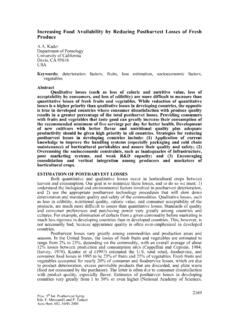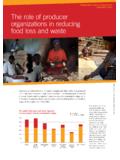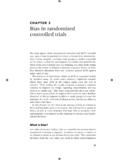Transcription of THE IMPORTANCE OF BIOSECURITY IN REDUCING HPAI …
1 THE IMPORTANCE OF BIOSECURITY IN REDUCING HPAI RISK ON FARMS AND IN MARKETS Food and Agriculture Organization of the United Nationsin collaboration withThe World Bank and The World Organisation for Animal Health (OIE)CONTENTSINTRODUCTION 1 DEFINING BIOSECURITY 1 IDENTIFYING RISK 2 BIOSECURITY MEASURES FOR RISK REDUCTION 4 THE ROLE OF GOVERNMENT AND PRIVATE ENTERPRISE 4 BIOSECURITY AND VETERINARY SERVICES 5 COSTS AND BENEFITS 6 FOUR DIRECTIONS TO FOLLOW
2 7 NOTES 8 COVER PHOTO:VIET NAM AO/H. WAGNERINTRODUCTIONThe current panzootic of highly pathogenic avian infl uenza (HPAI) has demonstrated that in many countries in which the potential for -2<.*<. =;*7<62<<287 2< 1201 " ,*778= .* sily be eradicated by stamping out and vac ,27*=287 875B %8 6*4. />;=1.; 9;80;.<< 27 * reas where disease has become entrenched, national authorities and other stakeholders must be encouraged to give higher priority to promoting and implementing measures to re duce the risk of disease transmission. Of these, the major component is BIOSECURITY . The key to sustainable control lies in implementing the highest possible BIOSECURITY measures in the.
3 7=2;. 9;8->,=287 ,87<>69=287 ,1*27 B 9;8 tecting poultry through BIOSECURITY we will also be protecting people. Raising the level of BIOSECURITY in the poul =;B <.,=8; 2< * 5870 =.;6 *99;8*,1 =1*= ;. quires fi nancial investment and behaviour change. However, the expected returns will +. 5870 =.;6 +. < /8; +8=1 9;8->,.;< *7- consumers in terms of reduced disease inci dence not only of HPAI but other diseases and their associated public health and economic impact. Promoting improved BIOSECURITY re quires international support and this is ap propriate considering the international public good resulting from improved HPAI control. DEFINING BIOSECURITYThe term BIOSECURITY has been used widely in the debate on HPAI control. It is variously described as an ideal state of affairs in which measures are in place to pre vent incursion and spread of disease, or the ap proach or principles used to achieve this state of affairs.
4 Depending on the source of the defi nition, the measures included under BIOSECURITY can be very broad or more narrowly defi ned, and may be applied on any scale from national poli cy to the management of an individual produc tion unit. In this paper, BIOSECURITY refers to those measures that should be taken to minimise the risk of incursion of HPAI into individual produc tion units (bioexclusion) and the risk of outward transmission (biocontainment) and onward transmission through the market chain. The value added of applying principles of BIOSECURITY (such as segregation1 and decon tamination) to production unit practices is that other disease will also be controlled. %1. <*6. 9;27,295.< ,*7 +. * =8 8 =1.; >72=< 27 * 9;8->,=287 ,87<>69=287 ,1*27 such as live bird markets or slaughterhouses. However the concept of BIOSECURITY in markets where poultry from various sources mix differs from that applied to farms.
5 CREDIT: EGYPT AO/P. PAGANI 7=.;7*=287*5 272<=.;2*5 87/.;.7,. 87 ?2*7 *7- "* , 7F>.7C* .@ .512 .,.6+.; 1It is reasonable to assume that if two farms are located in a similar environment and are 9*;= 8/ * <2625*; 9;8->,=287 ,87<>69=287 ,1*27 the one with higher BIOSECURITY represents a ;2<4 8/ ?2;> < 27=;8->,=287 *7- <9;.*- >= this does not imply that Sector 1 production >72=< +.,*> <. = 9;*,=2<. 1201 < 8/ +28 security, are completely free of risk. And if BIOSECURITY fails in a large industrial unit the impact will be much greater than that from a village production environment, because of the difference in the virus load produced and so the potential for spread of infection. Risk factorsThe major sources of risk for HPAI introduction and transmission are well known the intro duction of infected birds into fl ocks; contact with infected wild birds; movement of con taminated materials particularly containers, vehicles and personal clothing.
6 Direct airborne transmission of virus can occur, but generally over very short distances. Live bird markets have played a major role in spreading disease from unit to unit because they mix birds from many sources. Once virus has been introduced to an area, one of the factors responsible for maintaining it in poultry populations is high bird are recognised as being responsible for persistence, while terrestrial birds (mainly chickens and turkeys) are responsible for the amplifi cation of virus load. These factors vary among different types of production unit. 28<.,>;2=B 6.*<>;.< *;. 87. 8/ * ;*70. 8/ disease prevention and control instruments (including vaccination, surveillance, stamping out and compensation), none of which on its own constitutes the magic bullet . At the same time, poultry production premises in them <.
7 5?.< *;. ; )+28<.,>;. 78; )+28 27<.,>;. poultry production achieves BIOSECURITY in an 27,;. *5 /*<1287 6.*<>;.< =8 269;8?. +28 security build on measures already in place) and in decreasing order of IMPORTANCE (the major risks are addressed fi rst). Disease control requires the intelligent use of a combination of available measures adapted to the prevailing production and socioeconomic environment. IDENTIFYING RISKThe current H5N1 HPAI panzootic cannot be attributed to any one type of production sys tem alone: large and small farms have been affected and played a role in the spread and persistence of the disease. All production sys tems have their strengths and weaknesses, although some specifi c production and mar < 78=*+5B /;.. ;*70. ;.*;270 8/ ducks and poorly regulated live poultry mar kets, appear to have played a particularly im portant role in the maintaining the disease in certain regions.
8 A classifi cation of production systems (or sectors) was developed by FAO 27 +*<.- primarily on differences in BIOSECURITY . CREDIT:VIET NAM AO/H. WAGNER 7=.;7*=287*5 272<=.;2*5 87/.;.7,. 87 ?2*7 *7- "* , 7F>.7C* .@ .512 .,.6+.; of poultry farms rearing scavenging birds at home; and the practice of giving live birds as gifts to visitors and the obligation for visitors to accept). Many of these risk factors can be easily be reduced through simple and inexpensive pro-cedures but lack of knowledge often leads to bad application and unsafe behaviour (for e-xample, working in a dirty area and then mo-ving to a clean area rather than the reverse; failure to quarantine new birds; and generally poor hygiene). Examples of production units that deserve special consideration in risk management:s (ATCHERIES OUTSIDE INTEGRATED SYSTEMS RE-ceive eggs from a large number of sources and young birds are then widely distribu-ted; this high turn-over under often mini-mal levels of hygiene represents a high risk factor for the spread of the virus.
9 S &REE RANGING DUCK mOCKS ARE A SPECIAL CASE because unlike other large scale units they cannot be enclosed; it is almost impossi-ble to keep them separate from wild birds and in some countries they are moved over large distances, increasing the risk of transmission of HPAI from and to resident poultry. Backyard flocksThe risk for rural backyard flocks is reduced when they have low bird densities and the birds bought and sold are transported only over short distances and there is little or no disease in the vicinity. However there is risk when transport links connect local move-ments with long distance chains. Transport and marketsLive bird markets and the transport systems that carry birds from farms to markets or slaughterhouses each present specific risks of disease spread. Many markets, whether large or small, ur-ban or roadside, have a low standard of sani-tary conditions.
10 Markets that operate day in day out pose a higher risk than those that have closing days when premises can be di-sinfected. Those where birds of different ages and different species from different locations are mixed at the market, and then returned to their farm of origin or sold on to another farm, create the potential for disease spread over a wide area. It is often the case that the people trans-Analysis of risk must be based on a review of existing practices and these differ from system to system and situation to situation. It is important that risk analysis gives due recog-nition to local conditions and environments and that BIOSECURITY measures are tailored to these conditions. At the same time, it is true in all situations that the greatest risk of spread of disease lies in the movement of live animals and contaminated materials, so BIOSECURITY measures to reduce risk are heavily depen-dent on movement management.



















